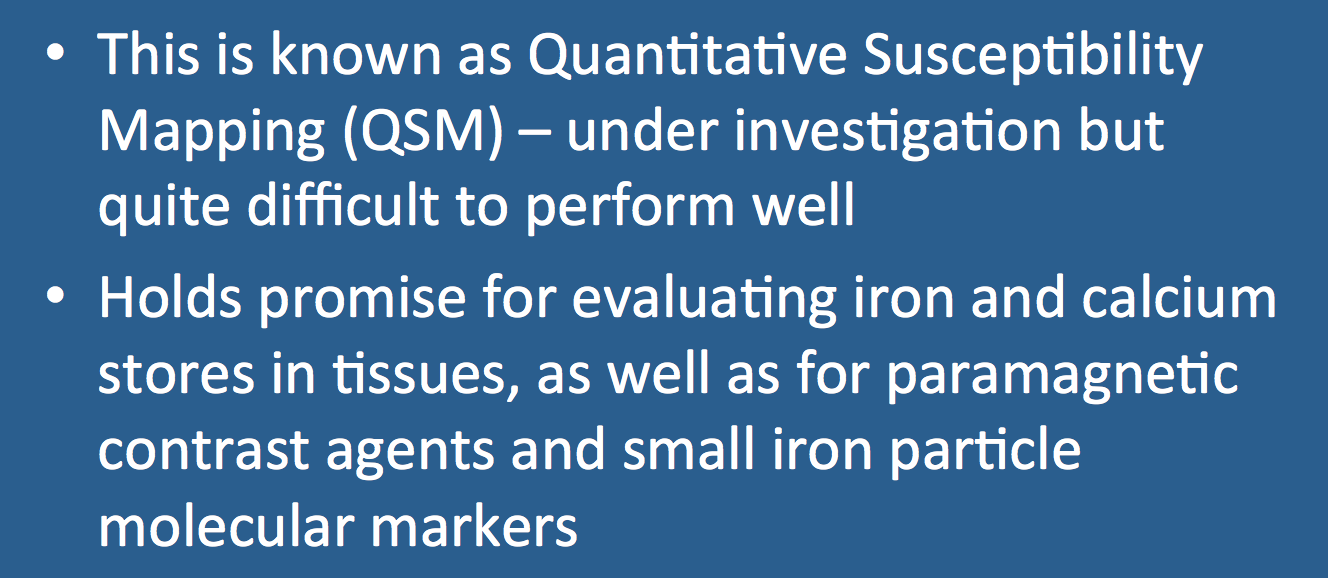Quantitative Susceptibility Mapping (QSM) comprises a group of largely experimental methods by which the absolute concentrations of iron, calcium and other substances may be measured in tissues based on changes in local susceptibility.
The acquisition sequence for QSM is typically a 3D GRE similar to that used for routine SWI, but multiple echoes are used to allow for detection of weak susceptibility changes and correction for multi-exponential T2*-decay. On our Siemens 3.0T scanner we use 6 echoes at TE's ranging from 10-44 ms with flow compensation in the readout direction.
Simple calculation of total phase shifts in an area is inadequate to produce accurate QS maps. Local susceptibility effects are highly dependent on the shape and orientation of the objects producing those shifts. For example, the phase (or frequency) change induced by a cylindrical structure (like a vein) has a sin²θ dependence on its direction relative to the main magnetic field. In theory for vessels running exactly parallel to the main field no phase shift should be observed though they contain paramagnetic deoxyhemoglobin; maximal phase shift will occur when they run perpendicular to the field (i.e., in plane for axial images). Another problem concerns QSM for regions containing both diamagnetic (calcium) and paramagnetic (iron) components. This is seen commonly in the basal ganglia as well as in certain vascular malformations and tumors. In this situation the positive and negative phase shifts may cancel each other out so that it may appear neither is present in a voxel.
|
Several models have been developed to analyze QSM data. Most are based on the concept that a small focus of paramagnetic or diamagnetic material can be represented as a magnetic dipole interacting with that material to create a local susceptibility field disturbance δB. These local field disturbances are normally swamped by much larger background field changes which must be removed. One of the currently popular methods for background field removal is called Projection onto Dipole Fields (PDF). After suitable background removal, an extraordinarily difficult mathematical inverse problem exists to calculate the individual dipole sources giving rise to the sum of these local field disturbances. Here, the Morphology Enabled Dipole Inversion Method (MEDI) is among the most commonly used.
|
Advanced Discussion (show/hide)»
No supplementary material yet. Check back soon!
References
Acosta-Cabronero J, Milovic C, Mattern H, et al. A robust multi-scale approach to quantitative susceptibility mapping. NeuroImaging 2018; 183:7-24.
Chen W, Zhu W, Kovanilkaya I, et al. Intracranial calcifications and hemorrhages: characterization with quantitative susceptibility mapping. Radiology 2014; 270:496-505.
Harada T, Kudo K, Fujima N, et al. Quantitative susceptibility mapping: basic methods and clinical applications. RadioGraphics 2022; 42: (in press) [DOI Link]
Labranche R, Gilbert G, Corny M, et al. Liver iron quantification with MR imaging: a primer for radiologists. RadioGraphics 2018; 38:392-412. (Describes conventional T2* mapping techniques for the liver as well as QSM methods).
Liu C, Li W, Tong KA, Yeom KW, Kuzminski S. Susceptibility-weighted imaging and quantitative susceptibility mapping in the brain. J Magn Reson Imaging 2015; 42:23-41 (good recent review).
Robinson SD, Bredies K, Khabipova D, et al. An illustrated comparison of processing methods for MR phase imaging and QSM: combining array coil signals and phase unwrapping. NMR Biomed 2017; 30:3601. (good recent review of different methods)
Wang Y, Liu T. Quantitative susceptibility mapping (QSM): decoding MRI data for a tissue magnetic biomarker. Magn Reson Med 2015; 73:82-101.
Acosta-Cabronero J, Milovic C, Mattern H, et al. A robust multi-scale approach to quantitative susceptibility mapping. NeuroImaging 2018; 183:7-24.
Chen W, Zhu W, Kovanilkaya I, et al. Intracranial calcifications and hemorrhages: characterization with quantitative susceptibility mapping. Radiology 2014; 270:496-505.
Harada T, Kudo K, Fujima N, et al. Quantitative susceptibility mapping: basic methods and clinical applications. RadioGraphics 2022; 42: (in press) [DOI Link]
Labranche R, Gilbert G, Corny M, et al. Liver iron quantification with MR imaging: a primer for radiologists. RadioGraphics 2018; 38:392-412. (Describes conventional T2* mapping techniques for the liver as well as QSM methods).
Liu C, Li W, Tong KA, Yeom KW, Kuzminski S. Susceptibility-weighted imaging and quantitative susceptibility mapping in the brain. J Magn Reson Imaging 2015; 42:23-41 (good recent review).
Robinson SD, Bredies K, Khabipova D, et al. An illustrated comparison of processing methods for MR phase imaging and QSM: combining array coil signals and phase unwrapping. NMR Biomed 2017; 30:3601. (good recent review of different methods)
Wang Y, Liu T. Quantitative susceptibility mapping (QSM): decoding MRI data for a tissue magnetic biomarker. Magn Reson Med 2015; 73:82-101.
Related Questions
How are susceptibility weighted images obtained and processed?
How are susceptibility weighted images obtained and processed?

